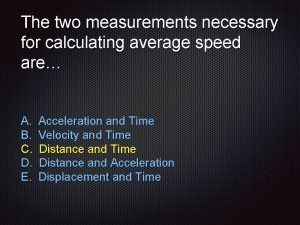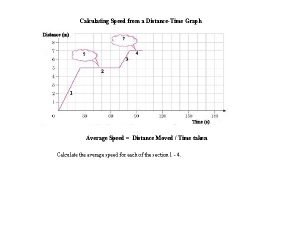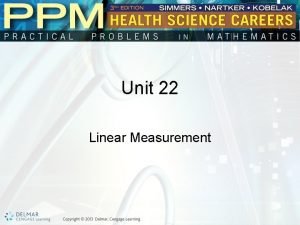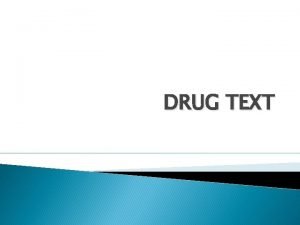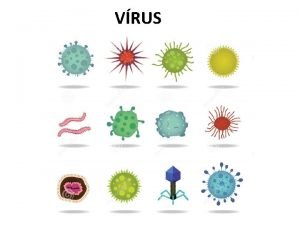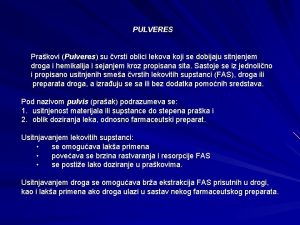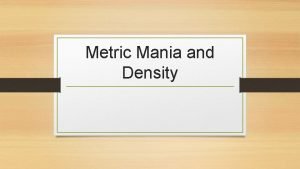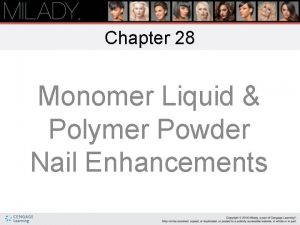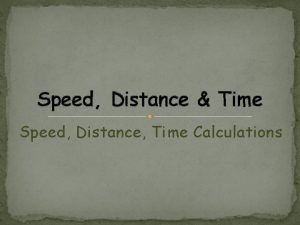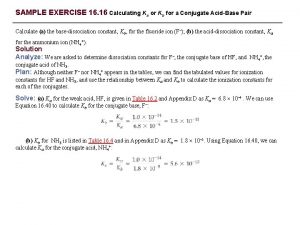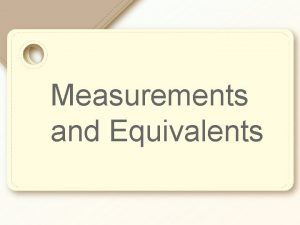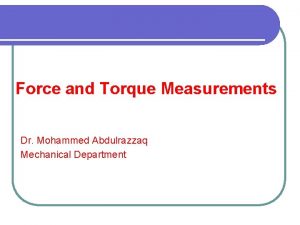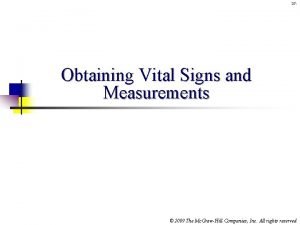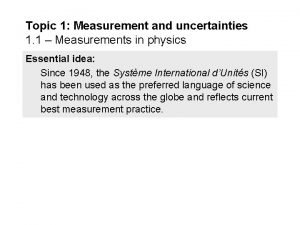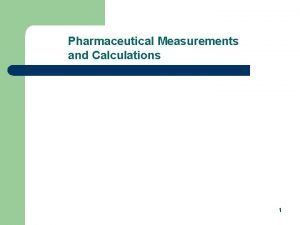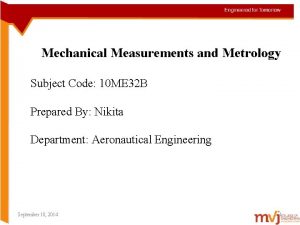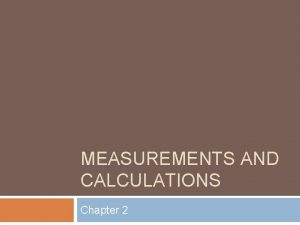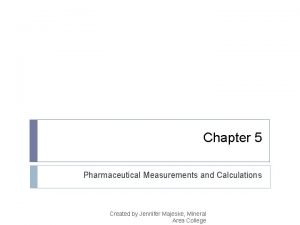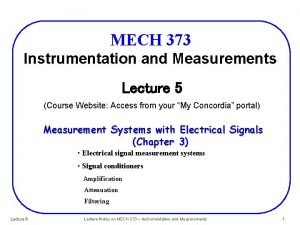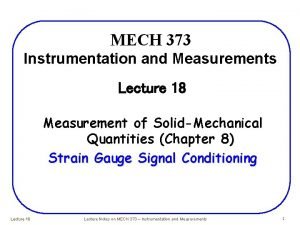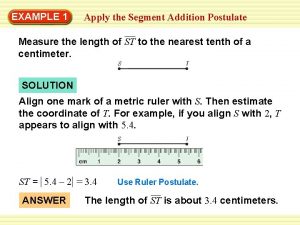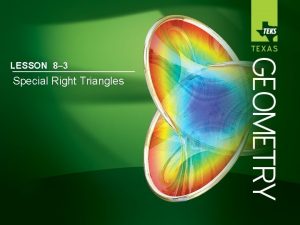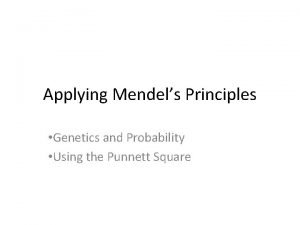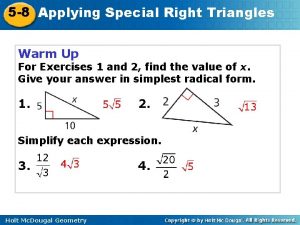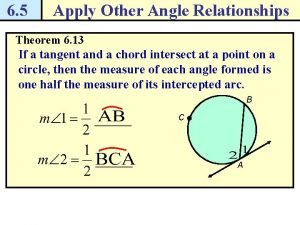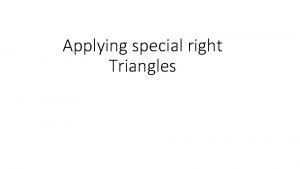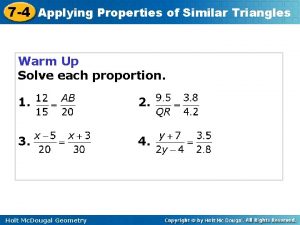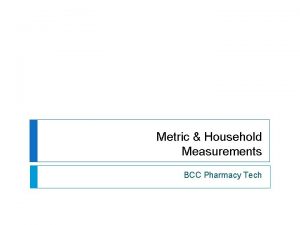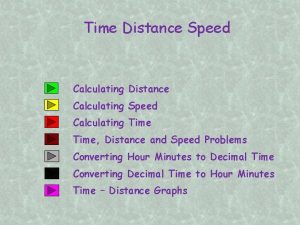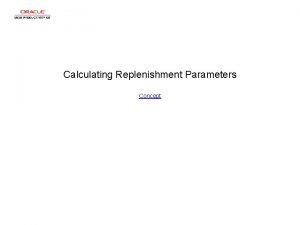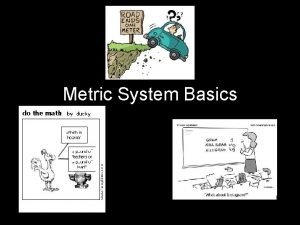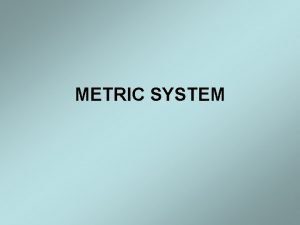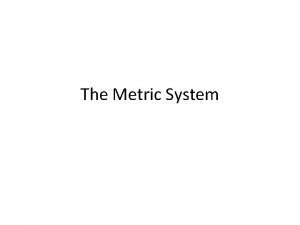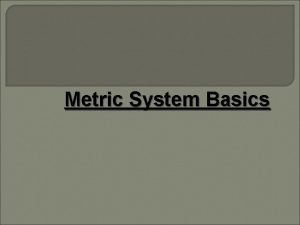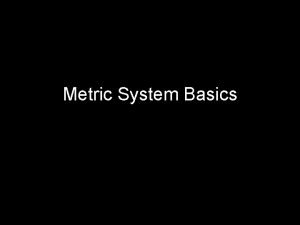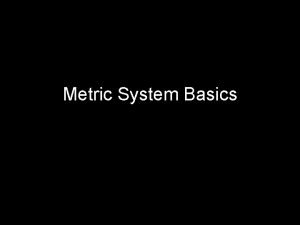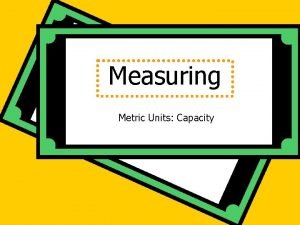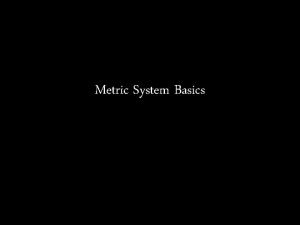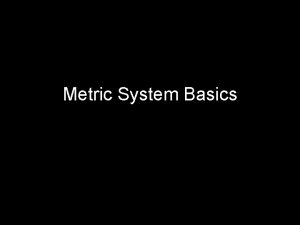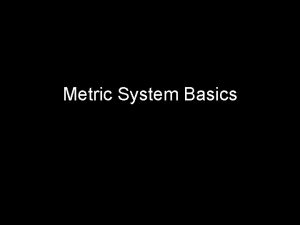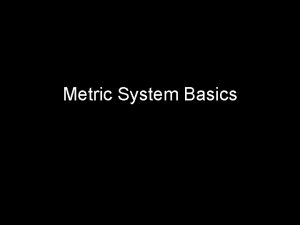MODULE 5 APPLYING METRIC MEASUREMENTS AND CALCULATING DOSES














































































































- Slides: 110

MODULE 5 APPLYING METRIC MEASUREMENTS AND CALCULATING DOSES RX TECH SUPPORT 1

Presentation Topics 4. 1 Basic Metric Units 4. 2 Conversions within the Metric System 4. 3 Problem Solving in the Pharmacy 4. 4 Customized Doses Rx TECH SUPPORT 2

Learning Objectives • Identify the basic units and prefixes of the metric system. • Convert units within the metric system by moving the decimal place, using the ratio-proportion method, and using the dimensional analysis method. RX TECH SUPPORT 3

Learning Objectives • Calculate drug doses using the ratio-proportion and dimensional analysis methods. • Calculate doses based on weight and body surface area (BSA). RX TECH SUPPORT 4

Learning Objectives • Calculate a pediatric dose using the patient’s weight or age and the appropriate adult dose. RX TECH SUPPORT 5

4. 1 Basic Metric Units Identifying Metric Units of Measure Using Metric Prefixes and Abbreviations RX TECH SUPPORT 6

Identifying Metric Units of Measure Metric Unit Measurement meter (m) length gram (g) weight liter (L) volume © PARADIGM PUBLISHING, INC. 7

Terms to Remember metric system a measurement system based on subdivisions and multiples of 10; made up of three basic units: meter, gram, and liter RX TECH SUPPORT 8

Terms to Remember meter the basic unit for measuring length in the metric system gram the basic unit for measuring weight in the metric system liter the basic unit for measuring volume in the metric system RX TECH SUPPORT 9

Identifying Metric Units of Measure 1 g is the weight of one cubic centimeter of water at 4° C 1 L = 1000 m. L 1 m. L = 1 cc RX TECH SUPPORT 10

Metric Prefixes Prefix Value nano (n) 1/1, 000, 000 (one-billionth of the basic unit, or 0. 00001) micro (mc) 1/1, 000 (one-millionth of the basic unit, or 0. 000001) milli (m) 1/1000 (one-thousandth of the basic unit, or 0. 001) centi (c) 1/100 (one-hundredth of the basic unit, or 0. 01) deci (d) 1/10 (one-tenth of the basic unit, or 0. 1) kilo (k) 1000 (one thousand times the basic unit) RX TECH SUPPORT 11

Metric Units Parts of a unit are written as decimal fractions. For example, two and a half milligrams is written as 2. 5 mg. RX TECH SUPPORT 12

Metric Abbreviations Weight ◦ ◦ kilogram = kg gram = g milligram = mg microgram = mcg RX TECH SUPPORT 13

Metric Abbreviations Volume ◦ ◦ kiloliter = k. L liter = L milliliter = m. L = cubic centimeter = cc microliter = mc. L RX TECH SUPPORT 14

Metric Abbreviations Length ◦ ◦ kilometer = km meter = m millimeter = mm micrometer = mcm RX TECH SUPPORT 15

Using Metric Prefixes and Abbreviations This amount of pasta is equivalent to 1 kg.

Using Metric Prefixes and Abbreviations These 3 paperclips weigh about 2 g.

Using Metric Prefixes and Abbreviations This soda bottle holds 2 L of liquid.

Using Metric Prefixes and Abbreviations For a decimal value less than 1, use a leading zero to prevent errors. RX TECH SUPPORT 19

Using Metric Prefixes and Abbreviations Pharmacy technicians should use the medication labels, not the color or shape of the pills, to confirm the amount of drug contained in a tablet or capsule. RX TECH SUPPORT 20

Using Metric Prefixes and Abbreviations Levothyroxine uses colors to help differentiate the strengths of the pills.

Discussion If a patient is to take 1. 2 g of cimetidine per day in four divided doses, which drug will be chosen? Answer: 0. 3 g/dose × 1000 mg/1 g = 300 mg/dose RX TECH SUPPORT 22

4. 2 Conversions within the Metric System Moving the Decimal Point Using the Ratio-Proportion Method Using the Dimensional Analysis Method RX TECH SUPPORT 23

Moving the Decimal Point The key to understanding the relationships in the metric system is to remember that the decimal point must be moved three places when converting from one unit to the next. ◦ ◦ 1 kg = 1000 g 1 g = 1000 mg 1 mg = 1000 mcg 1 L = 1000 m. L RX TECH SUPPORT 24

Moving the Decimal Point 0. 001 kg = 1000 mg = 1, 000 mcg 0. 001 k. L = 1000 m. L = 1, 000 mc. L 0. 001 km = 1000 mm = 1, 000 mcm RX TECH SUPPORT 25

Moving the Decimal Point Converting from smaller to larger unit of measure, move three places to the left. ◦ 4500 m. L = 4. 5 L ◦ 1287 mg = 1. 287 g ◦ 480 m. L = 0. 48 L RX TECH SUPPORT 26

Moving the Decimal Point Converting from larger to smaller unit of measure, move three places to the right. ◦ ◦ 0. 954 g = 954 mg 1. 5 g = 1500 mg 0. 238 g = 238 mg 0. 621 mg = 621 mcg RX TECH SUPPORT 27

Remember Moving the decimal point three spaces to the right is the same as multiplying by 1000. Moving the decimal three places to the left is the same as dividing by 1000. RX TECH SUPPORT 28

Using the Ratio-Proportion Method Set up a conversion by. . . 1. placing the unknown and the value to be converted on one side of the equation and 2. the conversion factor (the ratio of the desired unit to the given unit) on the other side. RX TECH SUPPORT 29

Conversion Example Change 2300 mg to grams. RX TECH SUPPORT 30

Conversion Example Change 3. 2 mg to micrograms. RX TECH SUPPORT 31

Using the Ratio-Proportion Method Set up a conversion by. . . 1. placing the unknown and the value to be converted on one side of the equation and 2. the conversion factor (the ratio of the desired unit to the given unit) on the other side. RX TECH SUPPORT 32

Remember When setting up proportions, units in the numerators must match, and units in the denominators must match. RX TECH SUPPORT 33

Using the Dimensional Analysis Method The given number and the unit are multiplied by the ratio of the desired unit to the given unit, which is equivalent to 1. The unit in the denominator will match the given unit, so the units will cancel each other out. The unit remaining in the numerator will be the unit to which we are converting. RX TECH SUPPORT 34

Remember If 1 g = 1000 mg, then Multiplying a number by 1 does not change its value. RX TECH SUPPORT 35

Conversion Example Convert 486 mg to grams. RX TECH SUPPORT 36

Conversion Example Convert 0. 725 mg to micrograms. RX TECH SUPPORT 37

Terms to Remember dimensional analysis method a conversion method in which the given number and unit are multiplied by the ratio of the desired unit to the given unit, which is equivalent to 1 RX TECH SUPPORT 38

Discussion If a patient is to take 1. 5 g of amoxicillin, how many capsules should the patient take? Answer: 6 capsules RX TECH SUPPORT 39

Discussion If a patient is to take 1. 5 g of amoxicillin, how many capsules should the patient take? Answer: 1. Convert 1. 5 g to milligrams: x mg / 1. 5 g = 1000 mg / 1 g; x mg = 1500 mg 2. Determine number of capsules: 1500 mg × 1 capsule / 250 mg = 6 capsules RX TECH SUPPORT 40

4. 2 Problem Set Drug Labels RX TECH SUPPORT 41

4. 2 Problem Set Drug Labels RX TECH SUPPORT 42

4. 3 Problem Solving in the Pharmacy Using the Ratio-Proportion Method to Solve Story Problems Using Dimensional Analysis to Calculate a Drug Dose RX TECH SUPPORT 43

Problem Solving in the Pharmacy Approach calculations in the pharmacy as “story problems. ” Begin by asking, “What am I looking for? ” The answer is usually a ◦ weight, expressed in milligrams, or ◦ volume, expressed in milliliters. RX TECH SUPPORT 44

Using the Ratio-Proportion Method for Story Problems Compare active ingredients in a carrier vehicle to other active ingredients in their vehicles. A vehicle is an inert medium, such as a syrup, in which a drug is administered. RX TECH SUPPORT 45

Terms to Remember vehicle an inert medium, such as a syrup, in which a drug is administered RX TECH SUPPORT 46

Using the Ratio-Proportion Method for Story Problems RX TECH SUPPORT 47

Remember When setting up proportions, units in the numerators must match, and units in the denominators must match. RX TECH SUPPORT 48

Using the Ratio-Proportion Method for Story Problems Step 1. Read through the entire problem and identify what the question is asking for. This becomes the variable x, labeled with the unit you are looking for such as x mg or x m. L. RX TECH SUPPORT 49

Using the Ratio-Proportion Method for Story Problems Step 2. Identify the prescriber’s order. Circle the dose ordered by the physician. RX TECH SUPPORT 50

Using the Ratio-Proportion Method for Story Problems Step 3. Identify the appropriate stock available in the pharmacy. The on-hand amount is nearly always a ratio such as 1 mg/tablet or 125 mg/5 m. L. Underline this information. This information is sometimes found on the labels of the drugs used in the pharmacy. RX TECH SUPPORT 51

Using the Ratio-Proportion Method for Story Problems Step 4. Identify extraneous information. It is often helpful to draw a single pencil line through any information you identify as not needed. This prevents you from using that information in your setup. RX TECH SUPPORT 52

Using the Ratio-Proportion Method for Story Problems Step 5. Estimate what your answer should be. Compare the ordered dose to what is on hand. Will the dose be larger or smaller than the dose unit given? RX TECH SUPPORT 53

Using the Ratio-Proportion Method for Story Problems Step 6. Use the ratio-proportion method to solve for x. When using the ratio-proportion method to solve your problem, place the physician-ordered dose on the left side of the proportion and the pharmacy on-hand ratio on the right side. RX TECH SUPPORT 54

Using the Ratio-Proportion Method for Story Problems Step 7. Round your answer to the appropriate number of significant figures. Weights are typically rounded to the nearest whole milligram, and volumes are typically rounded to the nearest tenth of a milliliter. RX TECH SUPPORT 55

Ratio-Proportion Method Example A physician has ordered 370 mg of a drug, and you have a 10 m. L vial of solution containing 250 mg/3 m. L on hand. How many milliliters will you measure out? Step 1. Read through the entire problem and identify what the question is asking for. This becomes the variable x, labeled with the unit you are looking for such as x mg or x m. L. We need to find out how many milliliters, so x m. L is the unknown. RX TECH SUPPORT 56

Ratio-Proportion Method Example A physician has ordered 370 mg of a drug, and you have a 10 m. L vial of solution containing 250 mg/3 m. L on hand. How many milliliters will you measure out? Step 2. Identify the prescriber’s order. Circle the dose ordered by the physician. In this problem, the physician has ordered 370 mg. RX TECH SUPPORT 57

Ratio-Proportion Method Example A physician has ordered 370 mg of a drug, and you have a 10 m. L vial of solution containing 250 mg/3 m. L on hand. How many milliliters will you measure out? Step 3. Identify the appropriate stock available in the pharmacy. Underline this information. In this problem, the pharmacy has 250 mg/3 m. L of the drug. RX TECH SUPPORT 58

Ratio-Proportion Method Example A physician has ordered 370 mg of a drug, and you have a 10 m. L vial of solution containing 250 mg/3 m. L on hand. How many milliliters will you measure out? Step 4. Identify extraneous information and draw a line through it. In this problem, it is not important to know that the drug comes in a 10 m. L vial. RX TECH SUPPORT 59

Ratio-Proportion Method Example A physician has ordered 370 mg of a drug, and you have a 10 m. L vial of solution containing 250 mg/3 m. L on hand. How many milliliters will you measure out? Step 5. Estimate what your answer should be. Compare the ordered dose to what is on hand. Will the dose be larger or smaller than the dose unit given? The ordered dose of 370 mg is larger than the dose strength of 250 mg, so the dose volume should be more than 3 m. L. RX TECH SUPPORT 60

Ratio-Proportion Method Example A physician has ordered 370 mg of a drug, and you have a 10 m. L vial of solution containing 250 mg/3 m. L on hand. How many milliliters will you measure out? Step 6. Use the ratio-proportion method to solve for x. RX TECH SUPPORT 61

Ratio-Proportion Method Example A physician has ordered 370 mg of a drug, and you have a 10 m. L vial of solution containing 250 mg/3 m. L on hand. How many milliliters will you measure out? Step 7. Round your answer to the appropriate number of significant figures. Since this is a liquid, round to the nearest tenth of a milliliter: 4. 44 m. L 4. 4 m. L. RX TECH SUPPORT 62

Using Dimensional Analysis to Calculate a Drug Dose Multiply the dose ordered by the ratio of the onhand supply. The ratio is set up so that the units of the given dose and the units in the denominator will cancel out. Use the steps for the ratio-proportion method, with a change in set-up in Step 6. RX TECH SUPPORT 63

Dimensional Analysis Example A physician has ordered 25 mg dose of hydrochlorothiazide. You have a 100 -count bottle of 50 mg tablets. What will you prepare to fill the order? Step 1. What is this problem asking for? The unknown is x tablets. RX TECH SUPPORT 64

Dimensional Analysis Example A physician has ordered 25 mg dose of hydrochlorothiazide. You have a 100 -count bottle of 50 mg tablets. What will you prepare to fill the order? Step 2. Circle the dose ordered by the physician. The prescribed amount is 25 mg. RX TECH SUPPORT 65

Dimensional Analysis Example A physician has ordered 25 mg dose of hydrochlorothiazide. You have a 100 -count bottle of 50 mg tablets. What will you prepare to fill the order? Step 3. Identify the stock available in the pharmacy. The pharmacy has 50 mg tablets. RX TECH SUPPORT 66

Dimensional Analysis Example A physician has ordered 25 mg dose of hydrochlorothiazide. You have a 100 -count bottle of 50 mg tablets. What will you prepare to fill the order? Step 4. Identify the extraneous information. The extraneous information includes “ 100 -count bottle. ” RX TECH SUPPORT 67

Dimensional Analysis Example A physician has ordered 25 mg dose of hydrochlorothiazide. You have a 100 -count bottle of 50 mg tablets. What will you prepare to fill the order? Step 5. Estimate the answer. The answer will be less than 1 tablet, as the requested dose is less than the amount of milligrams in 1 tablet. RX TECH SUPPORT 68

Dimensional Analysis Example A physician has ordered 25 mg dose of hydrochlorothiazide. You have a 100 -count bottle of 50 mg tablets. What will you prepare to fill the order? Step 6. Use dimensional analysis to solve the problem. RX TECH SUPPORT 69

Dimensional Analysis Example A physician has ordered 25 mg dose of hydrochlorothiazide. You have a 100 -count bottle of 50 mg tablets. What will you prepare to fill the order? Step 7. Round your answer to the appropriate number of significant figures. No rounding is required. RX TECH SUPPORT 70

4. 3 Problem Set Drug Labels RX TECH SUPPORT 71

4. 3 Problem Set Drug Labels RX TECH SUPPORT 72

4. 3 Problem Set Drug Labels

4. 3 Problem Set Drug Labels

4. 3 Problem Set Drug Labels

4. 3 Problem Set Drug Labels

4. 4 Customized Doses Calculating Doses Based on Weight Calculating Doses Based on Body Surface Area (BSA) Calculating Pediatric Doses RX TECH SUPPORT 77

Customized Doses Most manufacturers of drugs offer dose ranges as prescribing guidelines. In some cases, the suggested dose may be based on ◦ A patient’s weight or ◦ The patient’s weight and height RX TECH SUPPORT 78

Calculating Doses Based on Weight Important for parenteral, pediatric, or geriatric doses. Mediations with a low margin of safety. Usually milligram of medication per kilogram of body weight. RX TECH SUPPORT 79

Weight-Based Dose Example A patient weighs 60 kg, and she is to receive a medication of 15 mg/kg. What will her dose be? If the medication is available in a 300 mg capsule, how many will be dispensed? ◦ Part I. Determine the dose. ◦ Part II. Determine the number of capsules to be dispensed. RX TECH SUPPORT 80

Weight-Based Dose Example A patient weighs 60 kg, and she is to receive a medication of 15 mg/kg. What will her dose be? If the medication is available in a 300 mg capsule, how many will be dispensed? Part I. Determine the dose using the ratio-proportion method. RX TECH SUPPORT 81

Weight-Based Dose Example A patient weighs 60 kg, and she is to receive a medication of 15 mg/kg. What will her dose be? If the medication is available in a 300 mg capsule, how many will be dispensed? Part I. Determine the dose using the dimensional analysis method. RX TECH SUPPORT 82

Weight-Based Dose Example A patient weighs 60 kg, and she is to receive a medication of 15 mg/kg. What will her dose be? If the medication is available in a 300 mg capsule, how many will be dispensed? Part II. Determine the number of capsules to be dispensed using the ratio-proportion method. RX TECH SUPPORT 83

Weight-Based Dose Example A patient weighs 60 kg, and she is to receive a medication of 15 mg/kg. What will her dose be? If the medication is available in a 300 mg capsule, how many will be dispensed? Part II. Determine the number of capsules to be dispensed using the dimensional analysis method. RX TECH SUPPORT 84

Calculating Doses Based on Body Surface Area (BSA) Measurement based on weight and height variables Expressed as meters squared (m 2) Use nomograms to determine BSA RX TECH SUPPORT 85

Terms to Remember body surface area (BSA) a measurement related to a patient’s weight and height, expressed in meters squared (m 2), and used to calculate patient-specific doses of medications RX TECH SUPPORT 86

Nomogram for Estimating Body Surface Area of Children Calculating Doses Based on Body Surface Area (BSA ) Copyright © Novartis and used with permission RX TECH SUPPORT 87

Nomogram for Estimating Body Surface Area of Adults Calculating Doses Based on Body Surface Area (BSA ) Copyright © Novartis and used with permission RX TECH SUPPORT 88

Calculating Doses Based on Body Surface Area (BSA) Steps for Reading a Nomogram for Estimating BSA ◦ Step 1. Mark the patient’s height on the left column. RX TECH SUPPORT 89

Nomogram for Estimating Body Surface Area of Adults 62 inches tall Calculating Doses Based on Body Surface Area (BSA) Copyright © Novartis and used with permission RX TECH SUPPORT 90

Calculating Doses Based on Body Surface Area (BSA) Steps for Reading a Nomogram for Estimating BSA ◦ Step 1. Mark the patient’s height on the left column. ◦ Step 2. Mark the patient’s weight on the right column. RX TECH SUPPORT 91

Nomogram for Estimating Body Surface Area of Adults 62 inches tall 116 pounds Calculating Doses Based on Body Surface Area (BSA) Copyright © Novartis and used with permission RX TECH SUPPORT 92

Calculating Doses Based on Body Surface Area (BSA) Steps for Reading a Nomogram for Estimating BSA ◦ Step 1. Mark the patient’s height on the left column. ◦ Step 2. Mark the patient’s weight on the right column. ◦ Step 3. Draw a line or place a straight-edge ruler on the two marks. RX TECH SUPPORT 93

Nomogram for Estimating Body Surface Area of Adults 62 inches tall 116 pounds Calculating Doses Based on Body Surface Area (BSA) Copyright © Novartis and used with permission RX TECH SUPPORT 94

Calculating Doses Based on Body Surface Area (BSA) Steps for Reading a Nomogram for Estimating BSA ◦ Step 1. Mark the patient’s height on the left column. ◦ Step 2. Mark the patient’s weight on the right column. ◦ Step 3. Draw a line or place a straight-edge ruler on the two marks. ◦ Step 4. Read the BSA where the line intersects the center column. Read to the nearest one-half unit. RX TECH SUPPORT 95

Nomogram for Estimating Body Surface Area of Adults 62 inches tall 116 pounds Calculating Doses Based on Body Surface Area (BSA) BSA 1. 52 m 2 Copyright © Novartis and used with permission RX TECH SUPPORT 96

BSA Dose Example A patient is to receive a medication with the dose based on 50 mg/m 2. If the patient has a BSA of 0. 90 m 2, what will the dose be? If the medication is available only in 15 mg tablets, how many will be dispensed? ◦ Part I. Determine the dose. ◦ Part II. Determine the number of tablets to be dispensed. RX TECH SUPPORT 97

BSA Dose Example A patient is to receive a medication with the dose based on 50 mg/m 2. If the patient has a BSA of 0. 90 m 2, what will the dose be? If the medication is available only in 15 mg tablets, how many will be dispensed? Part I. Since the dose is to be based on 50 mg/m 2, multiply by the number of square meters of the BSA, in this case 0. 90. RX TECH SUPPORT 98

BSA Dose Example A patient is to receive a medication with the dose based on 50 mg/m 2. If the patient has a BSA of 0. 90 m 2, what will the dose be? If the medication is available only in 15 mg tablets, how many will be dispensed? Part II. Determine the number of tablets to be dispensed. RX TECH SUPPORT 99

BSA Dose Example A patient with a BSA of 1. 30 m 2 is to receive a medication with the dose based on 0. 80 mg/m 2. The prescription is to be divided into three equal doses. How much will each dose be? If the medication is available only as 50 mcg tablets, how many will be dispensed? ◦ Part I. Determine the dose. ◦ Part II. Determine the number of tablets to be dispensed. RX TECH SUPPORT 100

BSA Dose Example A patient with a BSA of 1. 30 m 2 is to receive a medication with the dose based on 0. 80 mg/m 2. The prescription is to be divided into three equal doses. How much will each dose be? If the medication is available only as 50 mcg tablets, how many will be dispensed? Part I. Multiply the number of mg/m 2 by the number of square meters of the BSA. RX TECH SUPPORT 101

BSA Dose Example A patient with a BSA of 1. 30 m 2 is to receive a medication with the dose based on 0. 80 mg/m 2. The prescription is to be divided into three equal doses. How much will each dose be? If the medication is available only as 50 mcg tablets, how many will be dispensed? Part II. Convert the dose in milligrams to micrograms, the units of the tablets, by using the equivalency 1 mg = 1000 mcg. RX TECH SUPPORT 102

BSA Dose Example A patient with a BSA of 1. 30 m 2 is to receive a medication with the dose based on 0. 80 mg/m 2. The prescription is to be divided into three equal doses. How much will each dose be? If the medication is available only as 50 mcg tablets, how many will be dispensed? Part II. Therefore, a dose is 350 mcg. Since the tables are 50 mcg each… RX TECH SUPPORT 103

Calculating Pediatric Doses It is sometimes appropriate to calculate a pediatric dose using the normal adult dose. ◦ Young’s Rule: bases suggested dose on years of age ◦ Clark’s Rule: bases suggested dose on weight RX TECH SUPPORT 104

Terms to Remember Young’s Rule a formula used to determine an appropriate pediatric dose by using the child’s age in years and the normal adult dose RX TECH SUPPORT 105

Pediatric Dose Example A 6 -year-old child needs a dose of a medication that has a suggested adult dose of 500 mg. Using Young’s Rule, what is the appropriate pediatric dose? RX TECH SUPPORT 106

Terms to Remember Clark’s Rule a formula used to determine an appropriate pediatric dose by using the child’s weight in pounds and the normal adult dose RX TECH SUPPORT 107

Pediatric Dose Example An 80 lb child needs a dose of a medication that has a suggested adult dose of 250 mg. Using Clark’s Rule, what is the appropriate pediatric dose? RX TECH SUPPORT 108

Pediatric Dose Example Calculate the dose of acetaminophen for a 5 -year-old child who weighs 44 lb (20 kg). The normal adult dose is 650 mg every 4 to 6 hours as needed. Determine the child’s dose. RX TECH SUPPORT 109

The End RX TECH SUPPORT 110
 What two measurements are necessary for calculating speed?
What two measurements are necessary for calculating speed? How to calculate average speed from a velocity time graph
How to calculate average speed from a velocity time graph Metric to household conversion
Metric to household conversion 3 units of linear measurements in metric system
3 units of linear measurements in metric system Metric system
Metric system Weights and measures training
Weights and measures training Botox injection sites
Botox injection sites Mechanism of action methylphenidate
Mechanism of action methylphenidate Belbuca doses
Belbuca doses Ppi equivalent doses
Ppi equivalent doses Augmentin pediatric dose chart
Augmentin pediatric dose chart Adderall dosage
Adderall dosage Virus latim
Virus latim Types of dose
Types of dose Topical semisolid dosage forms
Topical semisolid dosage forms Radolog
Radolog The monophasic liquid dosage form is solution
The monophasic liquid dosage form is solution Ambalism
Ambalism Pulveres simplices
Pulveres simplices Metric mania conversion challenge
Metric mania conversion challenge C device module module 1
C device module module 1 Chapter 33 applying paints and enamels
Chapter 33 applying paints and enamels Chapter 4 transactions that affect assets
Chapter 4 transactions that affect assets Monomer
Monomer When using monomer liquid and polymer powder, you:
When using monomer liquid and polymer powder, you: Chapter 17:11 providing first aid for sudden illness
Chapter 17:11 providing first aid for sudden illness Applying the perpendicular bisector theorem
Applying the perpendicular bisector theorem Speed time distance formula
Speed time distance formula Speed time distance formula
Speed time distance formula Time speed and distance formula
Time speed and distance formula Calculate intake and output
Calculate intake and output Kb from ka
Kb from ka Calculating iv infusion rate
Calculating iv infusion rate Calculating speed time and distance worksheet
Calculating speed time and distance worksheet Speed distance time
Speed distance time Measurements equivalents and adjustments
Measurements equivalents and adjustments Chapter 2 measurements and calculations
Chapter 2 measurements and calculations Force and torque measurements
Force and torque measurements Ee8403 measurements and instrumentation
Ee8403 measurements and instrumentation Temperature is an anthropometric measurement
Temperature is an anthropometric measurement Vital signs and measurements chapter 37
Vital signs and measurements chapter 37 Angle measure and segment lengths
Angle measure and segment lengths What are the 8 vital signs?
What are the 8 vital signs? Dr lucy jennifer
Dr lucy jennifer Measurements and uncertainties ib physics
Measurements and uncertainties ib physics Measurements and their uncertainty
Measurements and their uncertainty Pharmaceutical measurements
Pharmaceutical measurements Working principle of tool makers microscope
Working principle of tool makers microscope Metrology and measurements subject code
Metrology and measurements subject code Teaspoon abbreviation
Teaspoon abbreviation How to calculate percent error in chemistry
How to calculate percent error in chemistry Metric system in pharmacy
Metric system in pharmacy 5 physical quantities and their si units
5 physical quantities and their si units Using and expressing measurements
Using and expressing measurements Measurements and scientific tools lesson 2
Measurements and scientific tools lesson 2 Instrumentation and measurements
Instrumentation and measurements Instrumentation and measurements
Instrumentation and measurements Chapter 12 economic indicators and measurements
Chapter 12 economic indicators and measurements Using and expressing measurements
Using and expressing measurements Andalusian chicken incomplete dominance
Andalusian chicken incomplete dominance Applying critical approaches to literary analysis quiz
Applying critical approaches to literary analysis quiz Chapter 12 lesson 2 applying mendel's principles
Chapter 12 lesson 2 applying mendel's principles Applying angle relationships homework 2
Applying angle relationships homework 2 Applying the segment addition postulate
Applying the segment addition postulate What are the different literary approaches
What are the different literary approaches Food mixer
Food mixer Chapter 29 milady review questions
Chapter 29 milady review questions Applying gauss law cylindrical symmetry
Applying gauss law cylindrical symmetry Chapter 12 lesson 2 applying mendels principles
Chapter 12 lesson 2 applying mendels principles Applying the pythagorean theorem homework 3
Applying the pythagorean theorem homework 3 Applying properties of similar figures
Applying properties of similar figures Cognitive learning theorist
Cognitive learning theorist Applying agile approach in erp implementation
Applying agile approach in erp implementation Advice for applying machine learning
Advice for applying machine learning 5-8 applying special right triangles answer key practice a
5-8 applying special right triangles answer key practice a 5-8 applying special right triangles
5-8 applying special right triangles Special right triangles
Special right triangles Special right triangles investigation answers
Special right triangles investigation answers Pop cast complications
Pop cast complications Chapter 12 lesson 2 applying mendels principles
Chapter 12 lesson 2 applying mendels principles δqrs is a right triangle.
δqrs is a right triangle. 5-8 practice a applying special right triangles
5-8 practice a applying special right triangles Applying moral philosophies to business ethics
Applying moral philosophies to business ethics Applying learning theories to healthcare practice
Applying learning theories to healthcare practice Applying properties of similar triangles
Applying properties of similar triangles Applying mendels principles
Applying mendels principles Applying mendels principles
Applying mendels principles Applying reception school
Applying reception school 5-8 applying special right triangles
5-8 applying special right triangles Applying special right triangles
Applying special right triangles If a student driver commits a traffic violation
If a student driver commits a traffic violation Multiplying polynomials examples
Multiplying polynomials examples Sternberg's successful intelligence theory and wics model
Sternberg's successful intelligence theory and wics model Queer theory in literary criticism ppt
Queer theory in literary criticism ppt Applying educational theory in practice
Applying educational theory in practice Bleach concentration
Bleach concentration Applying angle relationships homework 2 answer key
Applying angle relationships homework 2 answer key Student development theory
Student development theory Applying critical approaches to literary analysis
Applying critical approaches to literary analysis Theorem 6-5
Theorem 6-5 Lesson 7-4 applying properties of similar triangles
Lesson 7-4 applying properties of similar triangles Applying a condom catheter
Applying a condom catheter Find y
Find y How to find the value of a right triangle
How to find the value of a right triangle 7-4 applying properties of similar triangles
7-4 applying properties of similar triangles Percentage yield practice questions
Percentage yield practice questions How to find theoretical yield
How to find theoretical yield Calculating unemployment rate
Calculating unemployment rate Percent difference formula
Percent difference formula Distance/speed
Distance/speed 3 approaches to gdp
3 approaches to gdp
